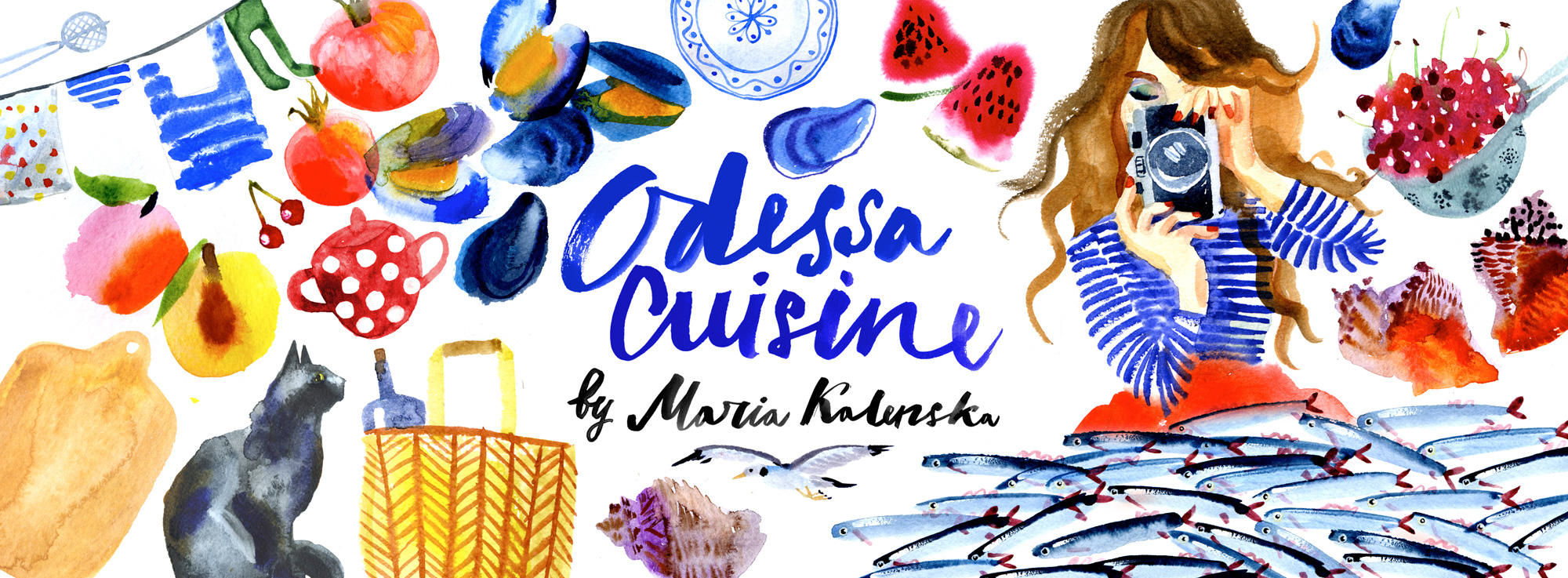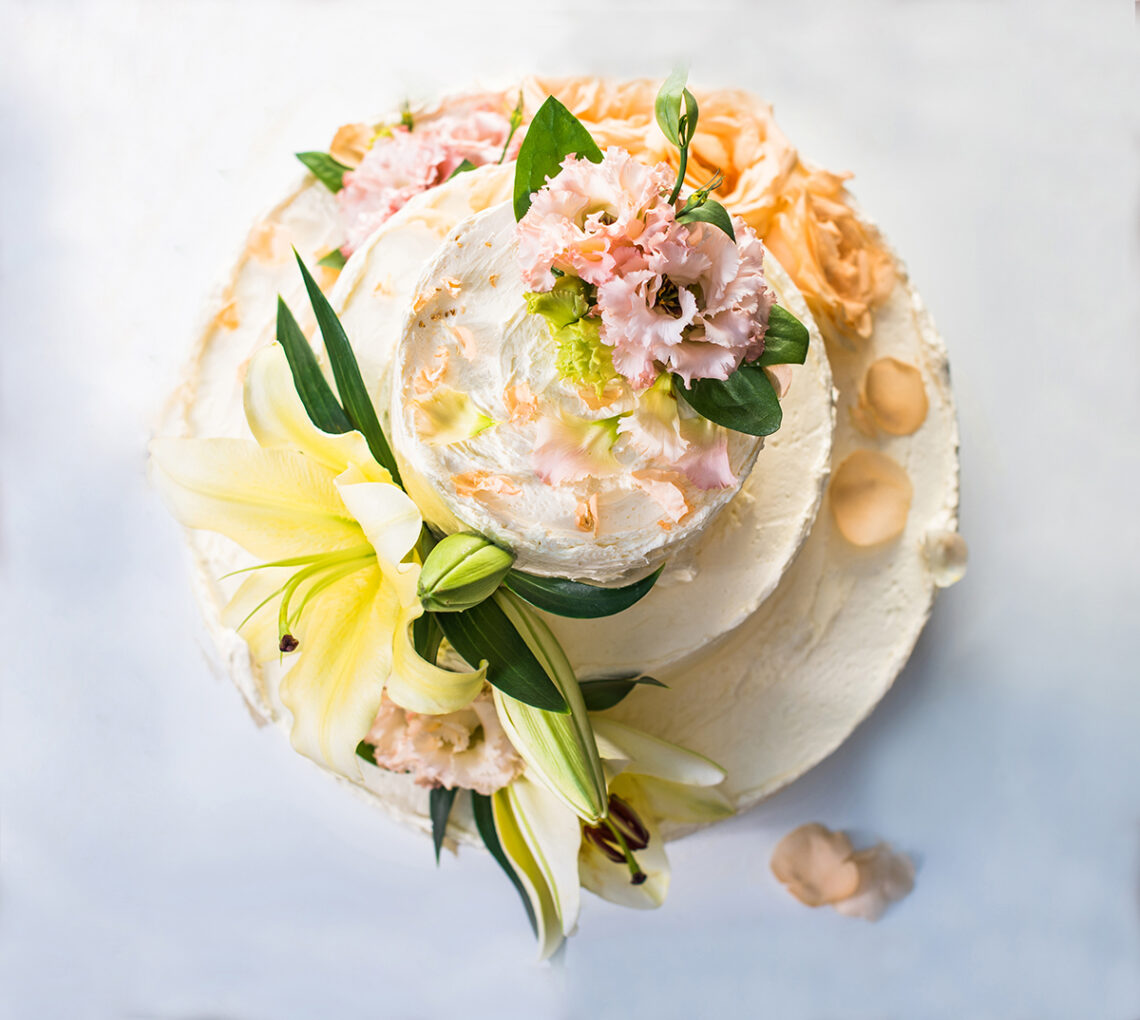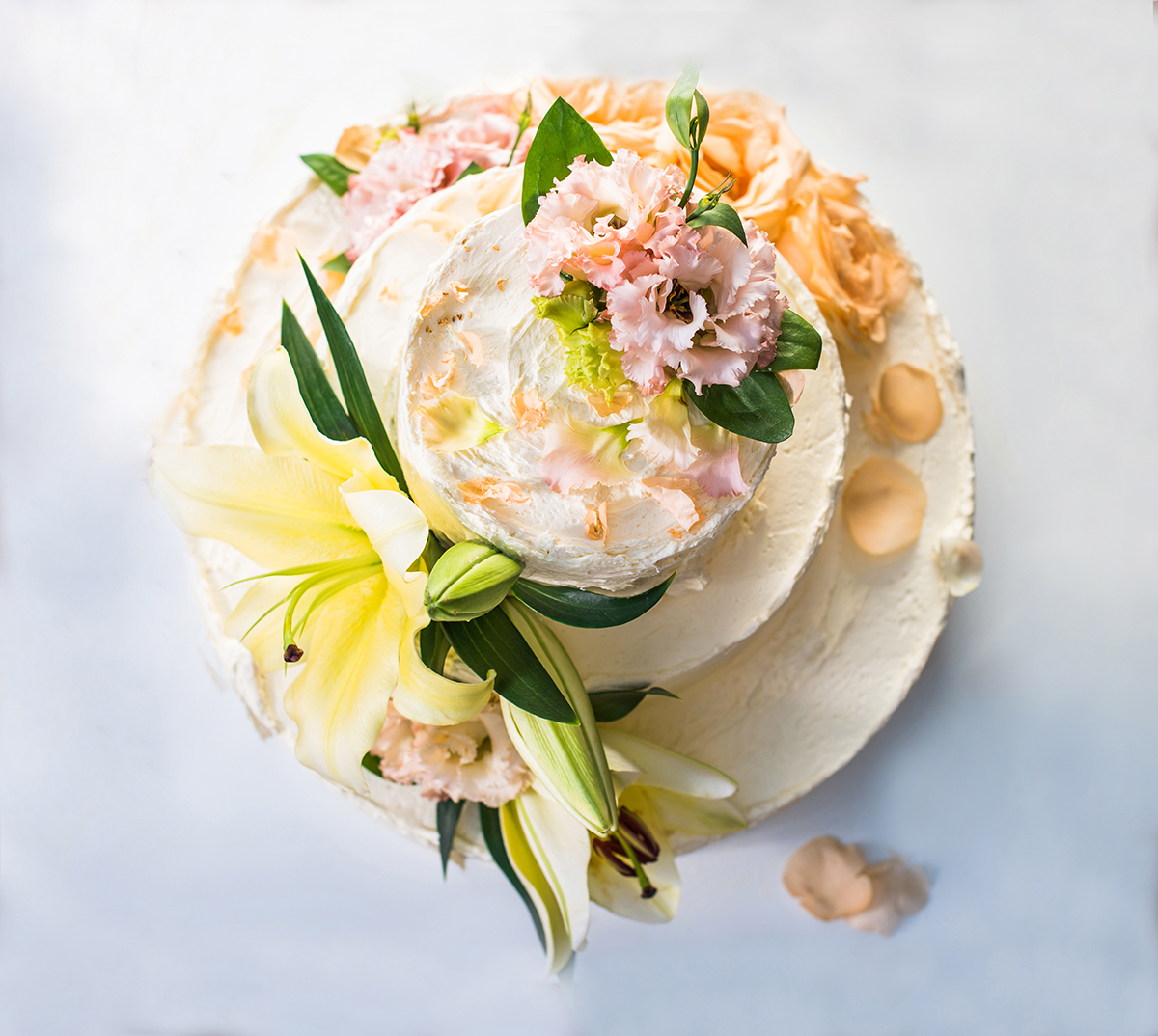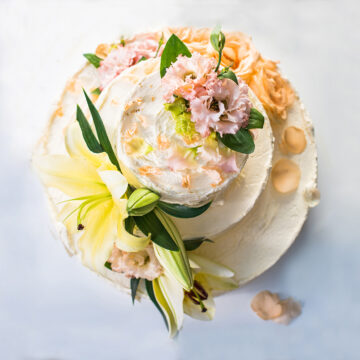The next morning, after this cake was cooked and eaten, two people woke up famous: Meghan Markle, who became the Duchess of Sussex, and Claire Ptak, the owner of a small bakery in London’s Hackney, who became wedding cakes trend setter. Lemon elderflower cake became a top seller at Violet Cake, its recipe spread all over the world, and Claire was the most welcome guest at events dedicated to wedding planning. Every British cafe has its own version of this cake. I also could not resist, found the recipe, natural elderflower syrup, Amalfi lemons, couple of French high-quality butter blocks, and decided to make the cake.
- Prep time: 1 hour 40 minutes + 40 minutes’ chilling
- Cook time: 1 hour 30 minutes
- Serves: 10-12
- Difficulty: challenging
- Course: cake
- Cookware: cake stand 23cm, 2 round 20cm cake tins, silicone spatula, pallet knife, cake wire leveller
- Cuisine: English
Ingredients
For the sponges:
- 6 eggs
- 400 g butter, room temperature
- 400 g sugar
- 400 g flour
- 8 g baking powder
- zest of 2 lemons
- juice of 1 lemon
- 100 ml elderflower syrup
- 100 ml Prosecco
- butter for greasing
For the icing:
- 5 egg whites
- 450 g icing sugar
- 100 ml elderflower syrup
- 500 g soft butter
- 7 tbsp lemon curd
For the decorations:
- edible lace
- fresh flowers
Cooking method
Step 1⠀
Heat the oven to 170°C. In a bowl, combine flour, baking powder, and zest. In a separate bowl, whisk the eggs lightly. Using a stand mixer beat the butter and sugar together until white. Then add the whipped eggs little by little, beating the mixture each time until smooth. Continuing beating, add flour with baking powder and zest and 50ml lemon juice. Bring the batter to an even mass.
Step 2
Butter the cake tins and line the base with parchment paper. Pour the cake mixture evenly into the two tins. Tap the tins lightly on the table to spread the batter. Bake for 40-50 minutes until golden brown. To check if the cake is ready, press it gently with your finger right in the middle. If the cake regains its shape, it is ready. Remove the cakes from the oven.


Step 3
In a small bowl, mix the elderflower syrup, Prosecco and 1 tbsp lemon juice. Divide the syrup into 2 parts. In 2 stages, spoon the syrup over the warm cakes, leave them to cool in the tins. Once completely cooled, remove them from the tins and discard the parchment paper. Cut each cake into 2 equal parts with the wire leveller.

Step 4
Make the icing. Add icing sugar and egg whites to the bain-marie and, stirring constantly with a spoon, bring the mixture to an even consistency. When steam begins to rise over the mixture, remove from heat and beat the mixture in a stand mixer for 8-10 minutes, until it is dense and shiny. Without ceasing to beat, gradually add elderflower syrup one tablespoon at a time. Set aside the egg whites mixture.


Step 5
Whisk butter and 1 tbsp lemon curd in a mixer until smooth. Without ceasing to whisk, gradually add egg whites mixture, one tablespoon at a time, until it ends. The icing is ready.

Step 6
Put 450g of icing into a separate bowl. Set the remaining icing aside. Place a spoonful of icing in the centre of the round cake stand to fix the cake. Put the first cake on the stand and cover evenly with the icing. Top with 2 tbsp lemon curd. Repeat the process for the second and third layers. Do not cover the fourth cake with icing. Lay out the cakes so that they are neatly stacked one above the other.


Step 7
Spread the thin layer of icing across the top and down the sides. Chill the cake in the refrigerator for 30 minutes. Remove the cake and cover with a second layer of icing using a pallet knife. Refrigerate for a further 30 minutes. Take out the cake, decorate and serve.

My tips and tricks:
 I want to simplify your task so that you can easily decide to cook even such a complex cake like this one. The advice is simple: break down the process into 3 days. On the first day, make the cakes, soak them and leave in the tins at room temperature, wrapping with cling film. The next day, you can make the icing and refrigerate it. You should get it out 2 hours before using so that the icing softens. The third day is the most creative and enjoyable day. The cake should be assembled and decorated with fresh flowers and delicate lace.
I want to simplify your task so that you can easily decide to cook even such a complex cake like this one. The advice is simple: break down the process into 3 days. On the first day, make the cakes, soak them and leave in the tins at room temperature, wrapping with cling film. The next day, you can make the icing and refrigerate it. You should get it out 2 hours before using so that the icing softens. The third day is the most creative and enjoyable day. The cake should be assembled and decorated with fresh flowers and delicate lace.
- For the sponges:
- 6 eggs
- 400 g butter, room temperature
- 400 g sugar
- 400 g flour
- 8 g baking powder
- zest of 2 lemons
- juice of 1 lemon
- 100 ml elderflower syrup
- 100 ml Prosecco
- butter for greasing
- For the icing:
- 5 egg whites
- 450 g icing sugar
- 100 ml elderflower syrup
- 500 g soft butter
- 7 tbsp lemon curd
- For the decorations:
- edible lace
- fresh flowers
- Heat the oven to 170°C. In a bowl, combine flour, baking powder, and zest. In a separate bowl, whisk the eggs lightly. Using a stand mixer beat the butter and sugar together until white. Then add the whipped eggs little by little, beating the mixture each time until smooth. Continuing beating, add flour with baking powder and zest and 50ml lemon juice. Bring the batter to an even mass.
- Butter the cake tins and line the base with parchment paper. Pour the cake mixture evenly into the two tins. Tap the tins lightly on the table to spread the batter. Bake for 40-50 minutes until golden brown. To check if the cake is ready, press it gently with your finger right in the middle. If the cake regains its shape, it is ready. Remove the cakes from the oven.
- In a small bowl, mix the elderflower syrup, Prosecco and 1 tbsp lemon juice. Divide the syrup into 2 parts. In 2 stages, spoon the syrup over the warm cakes, leave them to cool in the tins. Once completely cooled, remove them from the tins and discard the parchment paper. Cut each cake into 2 equal parts with the wire leveller.
- Make the icing. Add icing sugar and egg whites to the bain-marie and, stirring constantly with a spoon, bring the mixture to an even consistency. When steam begins to rise over the mixture, remove from heat and beat the mixture in a stand mixer for 8-10 minutes, until it is dense and shiny. Without ceasing to beat, gradually add elderflower syrup one tablespoon at a time. Set aside the egg whites mixture.
- Whisk butter and 1 tbsp lemon curd in a mixer until smooth. Without ceasing to whisk, gradually add egg whites mixture, one tablespoon at a time, until it ends. The icing is ready.
- Put 450g of icing into a separate bowl. Set the remaining icing aside. Place a spoonful of icing in the centre of the round cake stand to fix the cake. Put the first cake on the stand and cover evenly with the icing. Top with 2 tbsp lemon curd. Repeat the process for the second and third layers. Do not cover the fourth cake with icing. Lay out the cakes so that they are neatly stacked one above the other.
- Spread the thin layer of icing across the top and down the sides. Chill the cake in the refrigerator for 30 minutes. Remove the cake and cover with a second layer of icing using a pallet knife. Refrigerate for a further 30 minutes. Take out the cake, decorate and serve.


 The next morning, after this cake was cooked and eaten, two people woke up famous: Meghan Markle, who became the Duchess of Sussex, and Claire Ptak, the owner of a small bakery in London’s Hackney, who became wedding cakes trend setter. Lemon elderflower cake became a top seller at Violet Cake, its recipe spread all over the world, and Claire was the most welcome guest at events dedicated to wedding planning. Every British cafe has its own version of this cake. I also could not resist, found the recipe, natural elderflower syrup, Amalfi lemons, couple of French high-quality butter blocks, and decided to make the cake.
The next morning, after this cake was cooked and eaten, two people woke up famous: Meghan Markle, who became the Duchess of Sussex, and Claire Ptak, the owner of a small bakery in London’s Hackney, who became wedding cakes trend setter. Lemon elderflower cake became a top seller at Violet Cake, its recipe spread all over the world, and Claire was the most welcome guest at events dedicated to wedding planning. Every British cafe has its own version of this cake. I also could not resist, found the recipe, natural elderflower syrup, Amalfi lemons, couple of French high-quality butter blocks, and decided to make the cake.